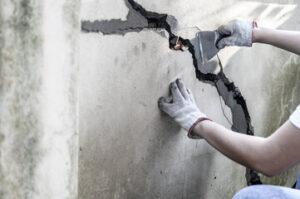Concrete Repair Is Easier and Less Expensive Than You Think
Concrete Repair used to have a bad rap, but thanks to new technology and better systems, it’s much faster and less expensive than concrete replacement. Concrete Repair Colorado Springs can also prevent structural problems from getting out of hand.
 First, figure out what caused the problem. This will help you decide which products and tools are best for the job.
First, figure out what caused the problem. This will help you decide which products and tools are best for the job.
Two primary objectives in repairing cracks in concrete are structural bonding and stopping water flow. For a structural bond, an epoxy injection method can be used. This requires a skilled contractor and is expensive. A urethane or rubber-like concrete repair material can be used for a watertight seal. Regardless of the repair material selected, a proper preparation of the surface is essential to ensure a long term repair.
Begin by cleaning the concrete surface to remove loose dirt and debris. A wire brush or stiff-bristle brush should be used to clean the crack and surrounding area. If the surface is particularly oily or grimy, a solvent like mineral spirits may be needed to remove excess oil or grease.
The next step in concrete Repair is to inspect the cracks for their severity and cause. Hairline cracks that only appear on the surface of patios, sidewalks and driveways are common and acceptable if they have not been caused by external stresses. Cracks that extend deeper into the concrete should be treated more seriously as they are likely the result of pressure or torque from an outside source, such as tree roots or ground swell.
For these types of cracks, a band-aid fix is possible by mixing a polymer-modified cement product in a bucket with water and wiping the resulting mud over the cracked areas. This is a quick, inexpensive repair but does not create a strong, lasting bond. It is also not appropriate for cracks that are deeper than 1/4″.
To properly repair these types of cracks, the first step is to chisel out the area to be filled. Make sure that the back of the chisel is facing into the crack — this will help to ensure that the filler will adhere to the main body of the concrete. Next, clean the crack of any loose gravel or debris that could prevent a strong bond.
If the concrete is still in good condition, a Simpson Strong-Tie concrete repair product can be applied directly to the crack. This is a great alternative to concrete resurfacing for those looking for a more cost-effective solution. It is recommended that a layer of silica sand be applied to the crack prior to applying the Simpson Strong-Tie concrete repair product.
This will help the crack to bond with the new concrete and to prevent future problems such as spalling or delamination. The final step in this type of concrete Repair is to spray a light coating of a bonding adhesive over the entire surface of the repaired crack. This is a critical step that should not be neglected, as it will prevent the crack from coming back and possibly requiring further repairs. For more information on this topic, see Concrete Repair and Maintenance Illustrated by Peter Emmons, published by R.S. Means Company.
Repairing Slabs
Concrete is an incredible material for many reasons, including its strength and durability. However, like any material, it will show signs of wear and tear over time that can lead to issues such as cracks, sinking, or settling. These issues can be a tripping or safety hazard, and they can also cause other problems with your home, such as doorways that stick or walls that are unlevel. The good news is, concrete Repair is easier and less expensive than you might think.
Until recently, concrete replacement was almost always the only solution for these types of issues, but now new technology and systems have made it possible to repair your concrete slabs instead. In fact, repairing concrete is often faster, cheaper, and more effective than replacing it altogether.
The most common concrete slab repair method is called PolyLevel, which uses a two-part polyurethane system to fill voids and lift your concrete back to its original position. The process is quick, noninvasive, aesthetically pleasing, and doesn’t retain moisture.
Before starting any concrete repair, you should determine the cause of the problem. This can help you decide which repair method is best suited for the situation and ensure that your concrete slab is repaired properly. A few of the most common causes of slabs that sink include soil erosion, underslab compaction, and even poor foundation design.
If the cause is soil erosion, you can use polyurethane soil stabilizers to prevent further deterioration of your slab. This is an effective and affordable method for preventing soil erosion around concrete, but it does not fix the root of the problem. In order to prevent further soil erosion and slab movement, you must install a proper drainage system.
For a less-invasive solution, you can also use polyurethane crack fillers to repair small cracks in your concrete slabs. These products can be purchased in a caulking tube and simply squeezed into the cracks to fill them. It’s important to remember that these products are not meant for structural repairs, and if the cracks are wide, you may need to dam them with Quikrete Backer Rod before using the filler.
Another type of concrete slab repair is mudjacking, which is the process of drilling holes through your concrete and pumping a compound underneath that fills voids and lifts the slab back to its original position. Mudjacking is a more expensive option than other types of concrete leveling, but it can be the best option if your slab is sinking due to soil erosion or poor foundation design. For this type of concrete leveling, you should hire a professional contractor for the best results.
Repairing Potholes
Concrete is one of the most durable materials mankind has ever invented. However, over time it can deteriorate and potholes form. It is possible to repair these deteriorated areas with specially formulated concrete patch and repair products. However, a successful concrete repair depends on correctly diagnosing the cause of the problem and doing the necessary preparation. Without these steps, the Repair will not last.
Before you can repair a pothole, you need to clean the area. This means removing any loose material with a shovel or broom. It is also important to clean the edges of the pothole, and to sand or scrub away any rough areas that are still exposed. This step is especially important if the pothole is in a public space, such as a road.
Once the area is cleaned, it is ready for the repair product. If you are working with a concrete repair product, mix it according to the package instructions. A quick-setting cement is ideal for this type of Repair, as it sets within minutes. For larger jobs, you may want to use a more traditional concrete repair product that is blended for specific tasks.
Both types of repair product are available in a range of different colours. For example, if you are repairing a pothole in a red tarmaced surface, choose Instant Road Repair Red. Once the patch has been mixed, spread it into the pothole, and fill in any gaps. Then smooth the surface with a power float or trowel, making sure it is smooth and level.
After the Repair has been made, it is important to allow it to dry properly. This will ensure that the Repair is strong and durable. To help the concrete or tarmac to cure, it is a good idea to mist the patch with water and cover it with plastic. This will protect the new surface from rain or snow that could wash away the Repair.
It is also a good idea to apply a coat of Sakrete Cure’ N Seal or Concrete and Paver Sealer after the pothole has been repaired. This will keep the patch protected from future damage, and it can also add a nice shine to the concrete. For most potholes, the best course of action is to get them fixed as soon as possible. This will help to prevent damage to the tyres of cars and other vehicles, as well as to the structure of the vehicle. If the pothole is too big for a do-it-yourself repair, it is best to contact a local contractor that has experience working with these types of surfaces. They can usually provide a free quotation. They will be able to advise on the best course of action and the most effective repair methods.






